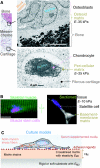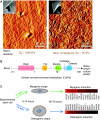Matrix elasticity, cytoskeletal forces and physics of the nucleus: how deeply do cells 'feel' outside and in?
- PMID: 20130138
- PMCID: PMC2816180
- DOI: 10.1242/jcs.041186
Matrix elasticity, cytoskeletal forces and physics of the nucleus: how deeply do cells 'feel' outside and in?
Abstract
Cellular organization within a multicellular organism requires that a cell assess its relative location, taking in multiple cues from its microenvironment. Given that the extracellular matrix (ECM) consists of the most abundant proteins in animals and contributes both structure and elasticity to tissues, ECM probably provides key physical cues to cells. In vivo, in the vicinity of many tissue cell types, fibrous characteristics of the ECM are less discernible than the measurably distinct elasticity that characterizes different tissue microenvironments. As a cell engages matrix and actively probes, it senses the local elastic resistance of the ECM and nearby cells via their deformation, and--similar to the proverbial princess who feels a pea placed many mattresses below--the cell seems to possess feedback and recognition mechanisms that establish how far it can feel. Recent experimental findings and computational modeling of cell and matrix mechanics lend insight into the subcellular range of sensitivity. Continuity of deformation from the matrix into the cell and further into the cytoskeleton-caged and -linked nucleus also supports the existence of mechanisms that direct processes such as gene expression in the differentiation of stem cells. Ultimately, cells feel the difference between stiff or soft and thick or thin surroundings, regardless of whether or not they are of royal descent.
Figures





References
-
- Alenghat F. J., Ingber D. E. (2002). Mechanotransduction: all signals point to cytoskeleton, matrix, and integrins. Science STKE 119, pe6 - PubMed
-
- Alexopoulos L. G., Williams G. M., Upton M. L., Setton L. A., Guilak F. (2005). Osteoarthritic changes in the biphasic mechanical properties of the chondrocyte pericellular matrix in articular cartilage. J. Biomech. 38, 509-517 - PubMed
-
- An S. S., Fabry B., Mellema M., Bursac P., Gerthoffer W. T., Kayyali U. S., Gaestel M., Shore S. A., Fredberg J. J. (2004). Role of heat shock protein 27 in cytoskeletal remodeling of the airway smooth muscle cell. J. Appl. Physiol. 96, 1701-1713 - PubMed
-
- Andrades J. A., Santamaria J. A., Nimni M. E., Becerra J. (2001). Selection and amplification of a bone marrow cell population and its induction to the chondro-osteogenic lineage by rhOP-1: an in vitro and in vivo study. Int. J. Dev. Biol. 45, 689-693 - PubMed
Publication types
MeSH terms
Grants and funding
LinkOut - more resources
Full Text Sources
Research Materials

